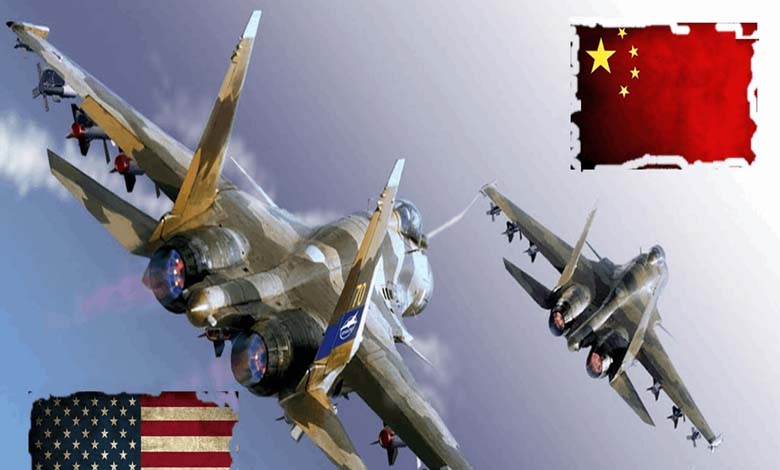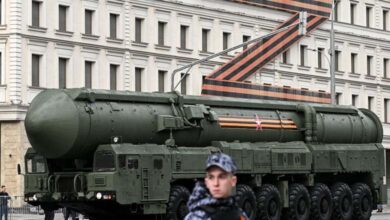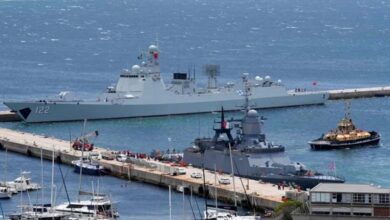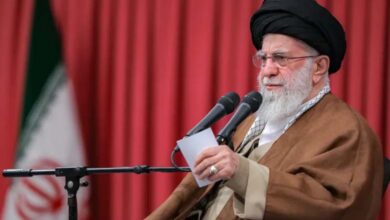Submarines, Missiles, and Fighters: A Comparison of Strategic Weapons between China and the United States

Amid escalating regional tensions, Iran is considering purchasing advanced stealth aircraft from China, reflecting a growing military alliance between the two countries.
-
Facing China and U.S. Ambiguity.. Japan Rebuilds Its Military Power
-
China bares its teeth… A major production leap for stealth fighters
This move follows the recent Indo-Pakistani war, which reports say showed Islamabad’s notable superiority supported by modern Chinese weaponry, prompting many countries to reassess their military options.
This highlights China’s expanding role in strategic weaponry and opens the door to a comprehensive comparison between the advanced military capabilities of China and the United States, both competing for global military dominance.
-
Sexual Assaults and Secret Deals: Andrew under FBI Investigation
-
The Technological Revolution and Irregular Warfare: Why is China Surpassing the U.S.?
United States: Advanced Weapons and Technological Leadership
The United States maintains a leading position in strategic weapons, benefiting from massive research and development investments and advanced military infrastructure.
Fifth-Generation Fighter F-35 Lightning II
Considered one of the most advanced fighter jets globally, the F-35 features sophisticated stealth technologies making it nearly invisible to radar. It has a glass cockpit with multiple touchscreen displays and advanced sensors providing comprehensive situational awareness to the pilot.
The aircraft carries medium and long-range air-to-air missiles within an internal weapons bay to maintain stealth, along with precision-guided bombs like JDAM and Paveway.
It flies at a maximum speed of about Mach 1.6, with a combat range of 1,200 kilometers, and some variants have vertical takeoff and landing capabilities.
-
NGAD: The American Sixth-Generation Fighter between Domination and Financial Drain
-
A Nuclear-Proof Facility Ten Times Bigger Than the Pentagon… Discover China’s “Fortress”
Fifth-Generation Fighter F-22 Raptor
The F-22 is the premier air superiority fighter, combining high stealth and superior flight performance.
It is armed with long-range AIM-120 AMRAAM missiles, short-range AIM-9 missiles, and an internal 20mm cannon.
The fighter exceeds Mach 2 in speed, flies up to 20,000 meters altitude with a high climb rate.
It played a significant role in the “Midnight Hammer” missions by providing air cover for B-2 bombers during strikes on Iranian facilities.
B-2 Spirit Bomber
A unique stealth strategic bomber capable of carrying 18 tons of munitions, including nuclear and bunker-busting weapons, with a range of thousands of miles without refueling.
Using advanced stealth technology and radar-absorbent design, it has been pivotal in long-range strikes such as those against Iranian nuclear sites, with some missions lasting 36 to 44 hours.
-
Artificial Intelligence in Warfare… When Machines Become Both Judge and Executioner
-
Washington Tests Military Capabilities Amid Escalation Between Israel and Iran
B-21 Raider Bomber
Next-generation stealth bomber with enhanced stealth capabilities, a more compact design (130–140 feet wingspan vs. 172 feet for the B-2), two engines instead of four, and reduced thermal and radar signature.
Equipped with smart composite materials, AI capabilities, and continuous network updates, it represents a qualitative leap over the B-2.
Patriot Air Defense System
An advanced surface-to-air missile defense system in service since 1984, produced by Raytheon, part of multilayered missile defense with interception ranges of 32 to 169 km.
Typically consists of a sophisticated radar, launch platforms, and a command center, capable of intercepting aircraft, drones, cruise missiles, and ballistic missiles.
US forces face inventory shortages, leading to suspension of deliveries to Ukraine.
The cost per missile launch ranges between $4 and $15 million, and the system is rapidly depleted in complex tactical environments.
-
Despite China’s penetration.. Why has the American strategy become important?
-
Washington doubts the seriousness of forming a naval alliance comprising Iran and Gulf states
THAAD System
A high-altitude missile defense system developed by Lockheed Martin, capable of intercepting short, medium, and long-range ballistic missiles through direct hit interception inside and outside the atmosphere.
 Comprises vertical launchers (8 missiles per platform), AN/TPY-2 radar, and command center, relying on precise target analysis and direct missile guidance.
Comprises vertical launchers (8 missiles per platform), AN/TPY-2 radar, and command center, relying on precise target analysis and direct missile guidance.
US forces expended 15-20% of their THAAD missile stockpile within just 11 days in Israel, revealing supply vulnerabilities and high costs ($10-15 million per missile) with heavy regional reliance.
US Aircraft Carriers: Nimitz and Gerald R. Ford Classes
The US Navy currently operates 11 aircraft carriers, 10 of the Nimitz class and one new Gerald R. Ford class.
These carriers are notable for their massive size and ability to remain at sea for extended periods thanks to nuclear propulsion.
Nimitz-class carriers weigh about 87,000 metric tons and use steam catapults for aircraft launches, while Gerald R. Ford class, at 100,000 tons, employs an advanced electromagnetic launch system (EMALS).
-
Washington denies transfer of Iranian enriched uranium before U.S. strike
-
Washington evacuates its nationals from the Middle East in preparation for any emergency
Each carrier can host about 75 aircraft, featuring more catapults, a larger flight deck, and additional elevators for faster aircraft deployment.
They serve as mobile command centers, floating airbases, and strategic deterrents allowing the US to project power worldwide.
Arleigh Burke-Class Destroyers
These destroyers form the backbone of the US destroyer fleet, boasting multi-role capabilities in air defense, missile defense, and anti-submarine warfare.
Equipped with the Aegis combat system providing integrated air and missile defense, Tomahawk missiles for land attack, and anti-ship and anti-submarine missiles.
Their key roles include escorting aircraft carriers, air and ballistic missile defense, and ground attack operations.
-
Nuclear Talks: Iran Rejects Washington’s Proposal, Prepares Alternative Offer
-
Between Washington and Tel Aviv… Is UNIFIL nearing the end of its mission in Lebanon?
China: Rapid Rise Toward Military Supremacy
Conversely, China aims to strengthen its position as a global military power by developing strategic weapons that compete with the United States, with a special focus on modern and advanced technologies.
Fifth-Generation Fighter Chengdu J-20
The J-20 is China’s first fifth-generation stealth fighter, featuring a design focused on stealth and speed.
Armament: short- and long-range air-to-air missiles such as PL-10, PL-15, and PL-21.
Performance: top speed up to Mach 2, combat range up to 2,000 kilometers, service ceiling of 20,000 meters.
Missions: air superiority, long-range strike, strategic operations.
-
Nuclear Talks: Iran Rejects Washington’s Proposal and Prepares an Alternative
-
One Trillion Dollars: The Cost for Europe to Break Free from Washington’s Hammer
Fifth-Generation Fighter Shenyang J-31
Another Chinese stealth fighter with an advanced design sharing some characteristics with the F-35, emphasizing fuel efficiency and speed.
Armament: internal weapons bay carrying up to 6 air-to-air missiles, with external hardpoints for larger missiles.
Performance: radar cross-section reducing design, equipped with an improved WS-19 engine.
Missions: air superiority, air-to-ground attack, multi-role operations.
Chinese Hypersonic Missiles
China possesses a growing arsenal of hypersonic missiles capable of evading traditional air defense systems at extremely high speeds.
Current number: about 600 hypersonic missiles, with plans to increase to 4,000 by 2025.
Significance: a new strategic threat altering rules of engagement and enhancing Chinese deterrence.
-
Washington Conditions Any New Nuclear Deal with Iran on Enrichment Oversight
-
Washington Wields the Maximum Pressure Card against Baghdad
Chinese Aircraft Carriers: Liaoning, Shandong, and Fujian
China owns three aircraft carriers: Liaoning (Type 001), Shandong (Type 002), and Fujian (Type 003).
Liaoning and Shandong are based on older Soviet designs, weighing approximately 60,000 and 66,000 tons respectively. They use a Short Take-Off But Arrested Recovery (STOBAR) system limiting aircraft weight and launch rate, capable of launching only one aircraft at a time.
The Fujian (Type 003) is China’s newest and largest carrier, weighing over 80,000 tons, and is the first to be fully designed and built domestically.
Notably, it uses an Electromagnetic Aircraft Launch System (EMALS), enabling the launch of heavier and more diverse aircraft. It can carry over 60 planes and provides a higher sortie launch rate.
Missions: enhance China’s ability to assert military presence in the Indian and Pacific Oceans and support long-range reconnaissance and air strike operations.
-
Due to Washington’s Refusal, Russia’s “Shadow Fleet” Remains Unchecked
-
Washington Accuses Two Individuals of Supplying Weapons to Iran That Killed 3 Americans
Type 055 Destroyers
Type 055 destroyers are among the world’s most powerful warships, sometimes classified as cruisers by some sources.
Capabilities: massive missile capabilities including air-to-air anti-ship missiles and land-attack missiles. Equipped with advanced radar systems and stealth features.
Missions: fleet air defense, anti-submarine warfare, and strikes on land and sea targets.
Comprehensive Comparison of Key Strategic Weapons
U.S. Nuclear Submarines: Advanced and Renewed Naval Power
Virginia-class nuclear attack submarines are the backbone of modern U.S. submarine forces, with the Navy aiming to increase production and accelerate output to meet growing global challenges.
-
Washington warns of a possible cut in relations between Israeli and Palestinian banks
-
Washington Seeks Normalization Between Israel and Saudi Arabia Before Presidential Elections

About 115 meters long, weighing around 7,800 tons, they can reach speeds of 34 knots underwater and dive to depths over 250 meters.
Virginia-class submarines perform multiple roles, including anti-submarine and surface ship warfare, intelligence gathering, precision strikes using Tomahawk cruise missiles, and special operations support. Enhanced versions have been developed to reduce maintenance and increase crew comfort, including dedicated female quarters.
To strengthen capabilities, the Department of Defense has signed major contracts with companies like General Dynamics and Huntington Ingalls to build new submarines and upgrade shipyards, targeting production of over two submarines annually by 2028, with plans for 66 submarines of this class by 2043.
The Virginia program is also a key part of the AUKUS security partnership, which includes providing Australia with advanced nuclear submarines.
-
Washington Secretly Warns Tehran of Suspicious Nuclear Activities
-
Taming the Dragon? Washington Approves Sale of Offensive Weapons to Taiwan
Chinese Nuclear Submarines: Rapid Expansion and Technological Development
Meanwhile, China seeks to expand its fleet of multi-mission nuclear submarines to bolster its maritime presence in the Indian and Pacific Oceans. China possesses advanced nuclear attack submarines and is developing new classes with improved stealth and advanced armament systems.
Chinese submarines can launch ballistic and cruise missiles, as well as advanced torpedoes, posing a strategic threat in potential maritime conflicts.
China is also focusing on enhancing underwater intelligence and combat capabilities, emphasizing stealth technologies to reduce detection by advanced sonar systems.
In the context of rapid naval expansion, nuclear submarines form a vital part of Beijing’s strategy to control critical sea lanes and secure its economic and strategic interests in the region.





















